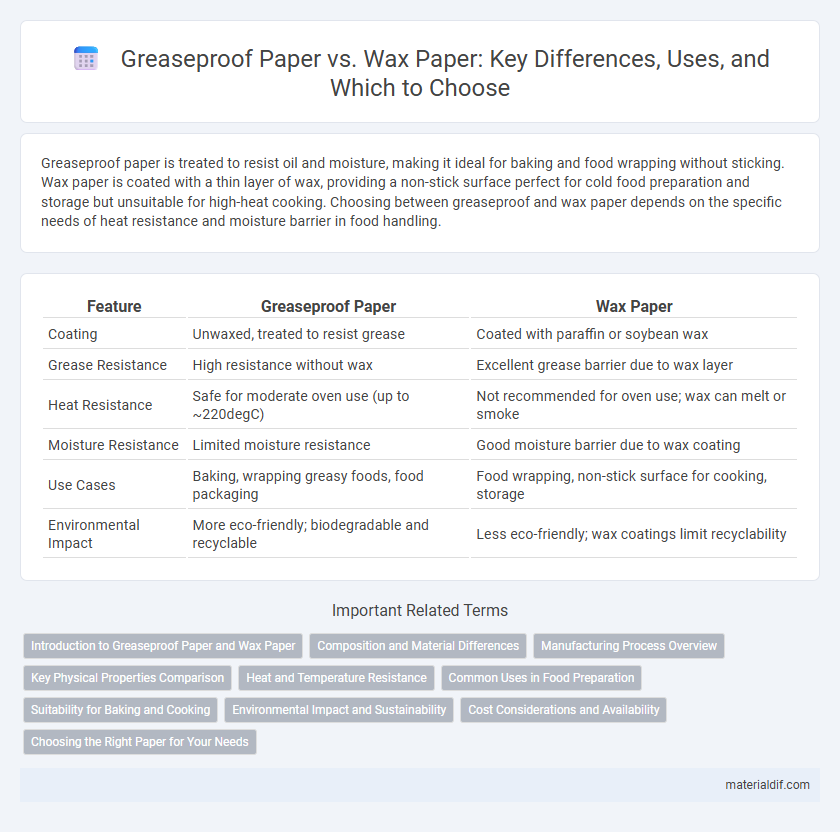Greaseproof paper is treated to resist oil and moisture, making it ideal for baking and food wrapping without sticking. Wax paper is coated with a thin layer of wax, providing a non-stick surface perfect for cold food preparation and storage but unsuitable for high-heat cooking. Choosing between greaseproof and wax paper depends on the specific needs of heat resistance and moisture barrier in food handling.
Table of Comparison
| Feature | Greaseproof Paper | Wax Paper |
|---|---|---|
| Coating | Unwaxed, treated to resist grease | Coated with paraffin or soybean wax |
| Grease Resistance | High resistance without wax | Excellent grease barrier due to wax layer |
| Heat Resistance | Safe for moderate oven use (up to ~220degC) | Not recommended for oven use; wax can melt or smoke |
| Moisture Resistance | Limited moisture resistance | Good moisture barrier due to wax coating |
| Use Cases | Baking, wrapping greasy foods, food packaging | Food wrapping, non-stick surface for cooking, storage |
| Environmental Impact | More eco-friendly; biodegradable and recyclable | Less eco-friendly; wax coatings limit recyclability |
Introduction to Greaseproof Paper and Wax Paper
Greaseproof paper is specially treated to resist oil and grease penetration, making it ideal for baking and food packaging applications that require moisture resistance without wax coating. Wax paper is coated with a thin layer of paraffin or soybean wax, providing a moisture barrier and non-stick surface primarily for wrapping and separating food items. Both papers serve distinct roles in culinary and packaging contexts, with greaseproof paper favored for heat resistance and wax paper for its pliability and moisture protection.
Composition and Material Differences
Greaseproof paper is made from unbleached or bleached wood pulp that is chemically treated to reduce its oil absorbency, creating a dense, non-greasy barrier ideal for baking and wrapping oily foods. Wax paper, by contrast, is typically produced by coating regular paper with paraffin wax or soybean wax, imparting a waxy surface that repels moisture and grease but melts at higher temperatures, limiting its use in ovens. The distinct composition results in greaseproof paper being more durable under heat, while wax paper excels as a moisture barrier without heat resistance.
Manufacturing Process Overview
Greaseproof paper is manufactured through a refining and chemical treatment process that removes fats and oils, creating a dense, absorbent sheet ideal for food wrapping. Wax paper production involves impregnating or coating paper with paraffin or soybean-based wax, providing a moisture-resistant, non-stick surface. The key difference lies in greaseproof paper's fiber treatment versus wax paper's external wax coating, influencing their suitability for various kitchen applications.
Key Physical Properties Comparison
Greaseproof paper features a dense, non-porous surface that resists oil and grease penetration, making it ideal for wrapping oily foods and liners. Wax paper is coated with a thin layer of paraffin wax that provides moisture resistance but can melt or smoke under high heat, limiting its use in cooking applications. Both papers offer moisture barriers, but greaseproof paper excels in heat tolerance and durability compared to wax paper.
Heat and Temperature Resistance
Greaseproof paper withstands higher temperatures, typically up to 220degC (428degF), making it ideal for baking and cooking applications where heat exposure is significant. Wax paper has a lower heat resistance, generally melting or smoking around 100degC (212degF), which limits its use to cold or room temperature tasks such as wrapping or food storage. Choosing greaseproof paper over wax paper ensures durability and safety during high-temperature cooking processes.
Common Uses in Food Preparation
Greaseproof paper is commonly used for baking and cooking as it provides a non-stick surface and resists oil penetration, making it ideal for lining baking trays and wrapping greasy foods. Wax paper is primarily used for wrapping and storing food due to its moisture-resistant but not heat-resistant properties, making it unsuitable for oven use but perfect for cold food storage. Both papers serve distinct roles in food preparation, with greaseproof paper favored for baking applications and wax paper preferred for food wrapping and refrigeration.
Suitability for Baking and Cooking
Greaseproof paper is ideal for baking as it is non-stick and heat-resistant up to around 220degC (428degF), preventing food from sticking and burning. Wax paper, coated with a thin layer of wax, is moisture-resistant but not heat-safe, making it unsuitable for oven use but perfect for wrapping and storing food or lining surfaces for non-heat tasks. Choosing greaseproof paper over wax paper ensures safe and effective results in cooking and baking applications.
Environmental Impact and Sustainability
Greaseproof paper is often more environmentally friendly than wax paper because it is typically biodegradable and recyclable, while wax paper is coated with paraffin or polyethylene, making it less eco-friendly and harder to decompose. The sustainable production of greaseproof paper involves fewer chemical treatments and less plastic coating compared to wax paper, reducing its overall carbon footprint and waste. Selecting greaseproof paper supports sustainable practices by minimizing plastic pollution and promoting material recovery through recycling processes.
Cost Considerations and Availability
Greaseproof paper typically costs less than wax paper due to its simpler manufacturing process and widespread availability in most supermarkets and baking supply stores. Wax paper, often coated with paraffin wax, tends to be pricier and may have limited availability in certain regions or specialty stores. For budget-conscious baking projects, greaseproof paper offers a more economical and easily accessible option without sacrificing essential moisture resistance.
Choosing the Right Paper for Your Needs
Greaseproof paper offers a non-stick, heat-resistant surface ideal for baking and cooking tasks where moisture needs to escape, while wax paper provides a moisture-proof barrier suited for wrapping and storing foods without heating. Selecting the right paper depends on whether your priority is moisture resistance, heat tolerance, or non-stick capabilities. Understanding these properties ensures optimal performance for specific culinary applications like baking, wrapping, or freezing.
Greaseproof paper vs Wax paper Infographic

 materialdif.com
materialdif.com